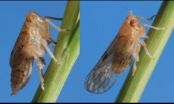(Press-News.org) The most extensive land-based study of the Amazon to date reveals it is losing its capacity to absorb carbon from the atmosphere. From a peak of two billion tonnes of carbon dioxide each year in the 1990s, the net uptake by the forest has halved and is now for the first time being overtaken by fossil fuel emissions in Latin America.
The results of this monumental 30-year survey of the South American rainforest, which involved an international team of almost 100 researchers and was led by the University of Leeds, are published today in the journal Nature.
Over recent decades the remaining Amazon forest has acted as a vast 'carbon sink' - absorbing more carbon from the atmosphere than it releases - helping to put a brake on the rate of climate change. But this new analysis of forest dynamics shows a huge surge in the rate of trees dying across the Amazon.
Lead author Dr Roel Brienen, from the School of Geography at the University of Leeds, said: "Tree mortality rates have increased by more than a third since the mid-1980s, and this is affecting the Amazon's capacity to store carbon."
Initially, an increase in carbon dioxide in the atmosphere - a key ingredient for photosynthesis - led to a growth spurt for the Amazon's trees, the researchers say. But the extra carbon appears to have had unexpected consequences.
Study co-author Professor Oliver Phillips, also from the University's School of Geography, said: "With time, the growth stimulation feeds through the system, causing trees to live faster, and so die younger."
Recent droughts and unusually high temperatures in the Amazon may also be playing a role. Although the study finds that tree mortality increases began well before an intense drought in 2005, it also shows that drought has killed millions of additional trees.
Dr Brienen said: "Regardless of the causes behind the increase in tree mortality, this study shows that predictions of a continuing increase of carbon storage in tropical forests may be too optimistic.
"Climate change models that include vegetation responses assume that as long as carbon dioxide levels keep increasing, then the Amazon will continue to accumulate carbon. Our study shows that this may not be the case and that tree mortality processes are critical in this system."
The study involved almost 100 scientists, many working for decades across eight countries in South America. The work was coordinated by RAINFOR, a unique research network dedicated to monitoring the Amazonian forests.
To calculate changes in carbon storage they examined 321 forest plots across the Amazon's six million square kilometres, identified and measured 200,000 trees, and recorded tree deaths as well as growth and new trees since the 1980s.
"All across the world even intact forests are changing", added Professor Phillips. "Forests
are doing us a huge favour, but we can't rely on them to solve the carbon problem. Instead, deeper cuts in emissions will be required to stabilise our climate."
INFORMATION:
Further information
The RAINFOR forest monitoring network has been supported principally by the Natural Environment Research Council (NERC), the Gordon and Betty Moore Foundation, and by the EU Seventh Framework Programme. Dr Roel Brienen is funded by a NERC Research Fellowship. Professor Oliver Phillips is supported by a European Research Council (ERC) Advanced Grant and is a Royal Society Wolfson Research Merit Award holder.
The research paper, 'Long-term decline of the Amazon carbon sink', is published in the journal Nature: http://dx.doi.org/10.1038/nature14283
Dr Roel Brienen and Professor Oliver Phillips are available for interview. Please contact Sarah Reed, Press Officer at the University of Leeds, on 0113 34 34196 or email s.j.reed@leeds.ac.uk.
Images
Images available for download: http://goo.gl/X5hAXV
Image 1: Amazon canopy at dawn, Brazil.
Credit: Peter van der Sleen
Image 2: Measuring Amazon trees, Peru.
Credit: Roel Brienen
Image 3: Flying buttresses prevent tree wind-throw, Colombia.
Credit: Peter Vitzum
Image 4: RAINFOR team monitoring the Amazon canopy, Peru.
Credit: Kuo-Jung Chao
Image 5: A map of the plots in the Amazon where tree measurements were taken for the study.
Credit: Credit Georgia Pickavance, RAINFOR / GLC2000
Videos
http://www.rainfor.org/en/videos
Credit: RAINFOR
Notes to editors
RAINFOR (http://www.rainfor.org) unites hundreds of scientists dedicated to monitoring Amazon ecosystems from the ground-up. The network is centred on permanent forest plots that track the lives of individual trees and species. The network emphasises careful, long-term, on-the-ground research to assess the behaviour of the world's most active carbon exchange system, and to understand the impact of Amazonia on the global climate. RAINFOR also fosters the development of young scientists and field technicians, working closely with
partners across the nations of Amazonia to help develop new generations of Amazon ecologists. The work of RAINFOR is currently supported by funding agencies in Brazil, Colombia, Peru, Venezuela, the UK (NERC), and the EU (European Research Council).
A full list of the 57 participating organisations from 15 countries is available at
http://www.rainfor.org.
Amazonia. At 6 million km2, the Amazon forest covers an area 25 times as great as the United Kingdom (or 15 times the size of California), and spans nine countries, or which by far the largest is Brazil. Large parts of Bolivia, Ecuador, Colombia, Peru, Venezuela, French Guyana, Guyana, and Suriname are also still covered by Amazon forests. This region contains one fifth of all species on Earth, including more than 15,000 tree species. Its three hundred billion trees store one fifth of all carbon in the Earth's biomass. The Amazon is also home to several million people, and water vapour from Amazonia nurtures agriculture further south, including the biofuel crops which power Brazil's cars. Each year Amazon forests cycle 18 billion tons of carbon, more than twice as much carbon as the combined emissions of all fossil fuels burnt in the world.
Messenger RNAs (mRNA) are linear molecules that contain instructions for producing the proteins that keep living cells functioning. A new study by UCL researchers has shown how the three-dimensional structures of mRNAs determine their stability and efficiency inside cells. This new knowledge could help to explain how seemingly minor mutations that alter mRNA structure might cause things to go wrong in neurodegenerative diseases like Alzheimer's.
mRNAs carry genetic information from DNA to be translated into proteins. They are generated as long chains of molecules, but ...
Many people in the UK feel a strong sense of regional identity, and it now appears that there may be a scientific basis to this feeling, according to a landmark new study into the genetic makeup of the British Isles.
An international team, led by researchers from the University of Oxford, UCL (University College London) and the Murdoch Childrens Research Institute in Australia, used DNA samples collected from more than 2,000 people to create the first fine-scale genetic map of any country in the world.
Their findings, published in Nature, show that prior to the mass ...
DURHAM, N.C. -- Each year, rice in Asia faces a big threat from a sesame seed-sized insect called the brown planthopper. Now, a study reveals the molecular switch that enables some planthoppers to develop short wings and others long -- a major factor in their ability to invade new rice fields.
The findings will appear Mar. 18 in the journal Nature.
Lodged in the stalks of rice plants, planthoppers use their sucking mouthparts to siphon sap. Eventually the plants turn yellow and dry up, a condition called "hopper burn."
Each year, planthopper outbreaks destroy hundreds ...
Researchers have linked antibiotic resistance with poor governance and corruption around the world.
Lead researcher Professor Peter Collignon from The Australian National University (ANU) School of Medicine said the increase in antibiotic-resistant infections was one of the greatest threats facing modern medicine.
In the United States alone, around 23,000 deaths and two million illnesses each year have been attributed to antibiotic-resistant bacteria.
"We found poor governance and higher levels of corruption are associated with higher levels of antibiotic resistance," ...
COLUMBUS, Ohio - Cardiovascular researchers at The Ohio State University Wexner Medical Center have shown that a protein known as MG53 is not only present in kidney cells, but necessary for the organ to repair itself after acute injury. Results from this animal model study are published in the journal Science Translational Medicine.
Previous work by Jianjie Ma, a professor and researcher in Ohio State's Department of Surgery and the Dorothy M. Davis Heart & Lung Research Institute, identified and proved that MG53 repairs heart, lung and skeletal muscle cells as well.
"MG53 ...
Although bike-sharing systems have attracted considerable attention, they are falling short of their potential to transform urban transportation.
A new study by University of Chicago Booth School of Business Assistant Professor Elena Belavina, INSEAD Professor of Sustainable Development Karan Girotra and INSEAD Ph.D. candidate Ashish Kabra found that it is possible for cities to increase ridership without spending more money on bikes or docking points -- simply by redesigning the network.
The researchers spent four months in Paris observing the Velib' bike-share system ...
While doctors almost always agree on a pathological diagnosis of invasive breast cancer, there is room for improvement when diagnosing atypia (or atypical ductal hyperplasia-ADH) and DCIS (ductal carcinoma in-situ), Anna Tosteson, ScD and Tracy Onega, PhD from Dartmouth-Hitchcock's Norris Cotton Cancer Center have found. The Dartmouth investigators, and national collaborators, published the study, "Diagnostic Concordance Among Pathologists Interpreting Breast Biopsy Specimens," today in JAMA.
"About 1.6 million breast biopsies are done every year in the U.S., yet in nearly ...
CORVALLIS, Ore. - A new study from Oregon State University suggests there is a relationship between low levels of vitamin D and depression in otherwise healthy young women.
OSU researchers found that young women with lower levels of vitamin D were more likely to have clinically significant depressive symptoms over the course of a five-week study, lead author David Kerr said. The results were consistent even when researchers took into account other possible explanations, such as time of year, exercise and time spent outside.
"Depression has multiple, powerful causes ...
Interviewing women at a breast-imaging center in an urban safety net institution before and after they used a "mHealth" mobile health app on a tablet, Elissa Ozanne, PhD from Dartmouth's Norris Cotton Cancer Center and colleagues concluded that older, diverse, and low income women found it easy to use and acceptable. Published in the Journal of Health Disparities Research Practices, the paper with these findings is "Can mHealth Improve Risk Assessment in Underserved Populations? Acceptability of a Breast Health Questionnaire App in Ethnically Diverse, Older, Low-Income ...
Biochemists at the Ruhr-Universität Bochum have gained new insights into the generation and maintenance of circadian rhythms. They demonstrated that the Ras protein is important for setting the phase of such a circadian clock, as its activity determines the period length of the rhythm. Ras is also contributing to induce phase-shifts in circadian rhythms in response to external time cues such as light. The team headed by Prof Dr Rolf Heumann published their results in the magazine "Molecular Neurobiology".
Ras activity varies throughout the day
The circadian clock ...


